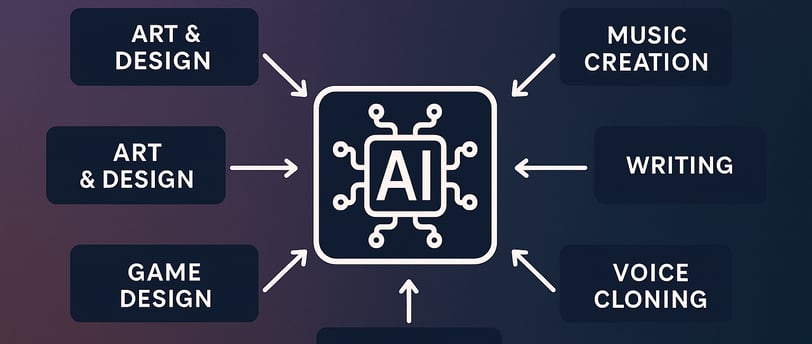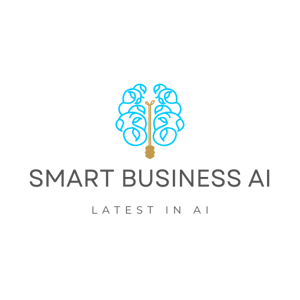THANK YOU FOR VISITING
From Fiction to Function: AI Use Cases Once Thought Impossible
SEO Keywords: creative AI use cases, AI in music and film, futuristic AI tools
Smart Business AI Team
5/11/20253 min read


Just a few years ago, the idea of writing a song with a few typed words, generating a movie trailer from a sentence, or creating digital artwork from imagination sounded like science fiction. In 2025, it's everyday reality.
Artificial Intelligence is now bridging the gap between imagination and execution. Creators, entrepreneurs, and everyday users are using AI to do things once considered impossible — and the pace of innovation is accelerating.
In this post, we explore futuristic, real-world AI use cases that have moved from fiction to function.
1. AI Video Generation: Text to Cinema in Minutes
In 2025, you can describe a scene — “a child flying over a city at sunset” — and AI will generate a fully animated, cinematic-quality video. This is thanks to text-to-video models like:
Sora by OpenAI
Runway Gen-2
These tools understand visual structure, motion, and cinematic logic, making it possible for filmmakers, marketers, and educators to bring their stories to life—no film crew required.
Who’s using it?
Indie filmmakers producing trailers
E-learning creators developing explainer videos
Brands visualizing product stories in seconds
2. AI Music Creation: Songs from Text Prompts
Platforms like Suno AI and Udio are transforming the music industry by letting anyone create studio-quality tracks in any genre—without knowing how to play an instrument or operate production software.
You simply type in a prompt like “lo-fi hip hop beat with a dreamy vibe” and receive a fully mastered track.
Use cases:
YouTubers creating royalty-free music
Game developers generating ambient soundtracks
Artists experimenting with new sounds
3. AI Art and Design: Imagination Becomes Visual Reality
With tools like Midjourney, DALL·E 3, and Leonardo.AI, users can generate original digital artwork, concept illustrations, or product mockups just by describing them.
Prompts like “futuristic café in Tokyo with neon lights” become stunning visuals in under a minute.
Creative fields being disrupted:
Graphic design
Product packaging
Book covers
Interior concept visualization
4. AI for Writing Novels and Scripts
Writing an entire novel, TV show outline, or screenplay used to take months. Today, tools like ChatGPT, Claude 3, and Sudowrite can help writers generate characters, dialogues, plots, and even poetic styles on demand.
Real-world examples:
Self-published authors co-writing books with AI
Scriptwriters prototyping stories for Netflix pitches
Journalists using AI for feature outlines and scene structures
This democratizes creativity, giving every aspiring writer the tools of a professional storyteller.
5. AI Voice Cloning and Speech Synthesis
AI can now replicate human voices with stunning accuracy. Tools like ElevenLabs and Descript Overdub allow users to:
Generate voiceovers in any tone or language
Create audiobooks without a human narrator
Recreate historical figures or celebrities (for ethical use)
Use cases:
YouTube creators producing multilingual videos
Podcasters generating quick ads
Filmmakers dubbing characters in post-production
6. AI-Powered Avatars and Virtual Humans
Virtual humans created with AI are hosting live streams, delivering training content, and interacting with customers. Tools like Synthesia and Hour One enable users to turn text into talking-head videos using realistic avatars.
Application areas:
Corporate training
E-learning
Product tutorials
News summaries
This drastically cuts production costs and time while offering 24/7 scalability.
7. AI in Game Design and Storytelling
Game developers now use AI to dynamically generate levels, adapt storylines to player behavior, and even voice NPCs in real-time.
Examples:
Procedural game worlds powered by AI storytelling engines
AI chatbots embedded into NPCs for lifelike interactions
Custom quests built around user decisions
It’s a level of personalization and immersion that was unthinkable a few years ago.
8. Futuristic Yet Functional: What These Innovations Mean
These AI use cases aren’t gimmicks—they’re radically redefining how we create and interact with content. The tools have become:
Affordable — Many are freemium or pay-per-use
Accessible — No technical background needed
Scalable — Usable for solopreneurs or large studios
They allow anyone with an idea to create a polished, market-ready output—blurring the line between hobbyist and professional.
Final Thoughts
From generating movies to composing music and writing books, AI is doing what was once unimaginable—at scale, speed, and accessibility never seen before.
We’re witnessing a creative renaissance led not by large production houses, but by everyday creators empowered by AI. And the tools are only getting better.
Curious about what’s next in AI creativity?
Subscribe to our newsletter to stay inspired and discover the newest AI innovations before they go mainstream.
Subscribe
contact@smartbusinessai.cloud
© 2025. All rights reserved.
